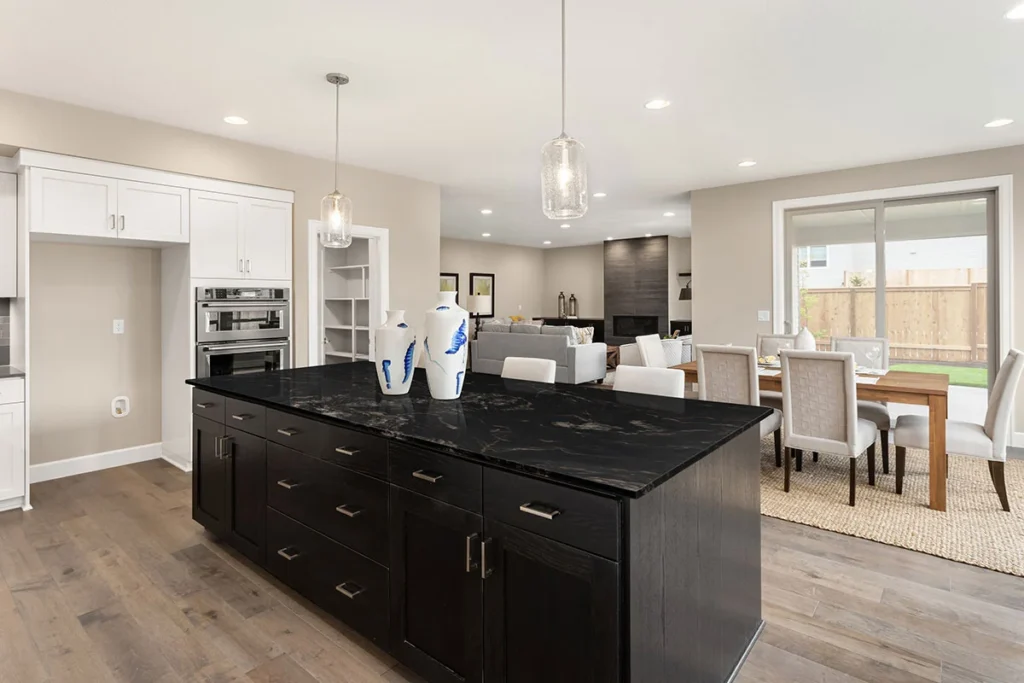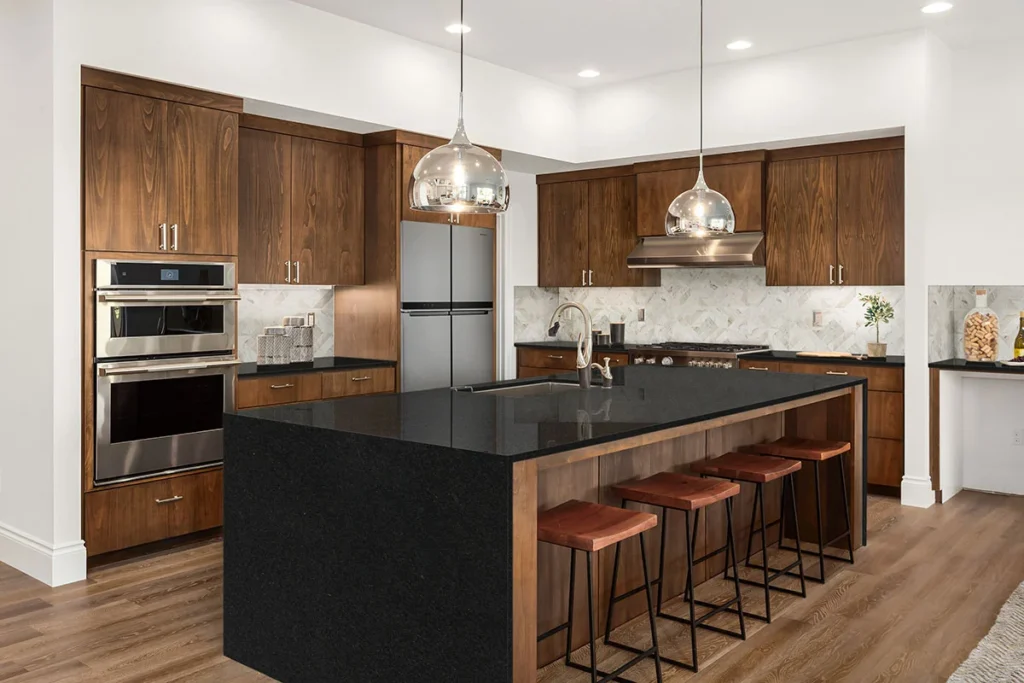Leathered Granite Countertops | Elevate Your Kitchen Style
Leathered granite countertops offer a unique and distinctive alternative to traditional polished granite surfaces. In contrast to the glossy finish of polished granite, leathered granite undergoes a process that creates a textured, matte appearance reminiscent of leather, hence the name.
This technique involves roughing up the surface of the granite slab with diamond-tipped brushes, resulting in a slightly pebbled texture that enhances the stone’s natural beauty and depth.
Types of Leathered Granite Countertops

Leathered granite countertops offer a unique and sophisticated look for kitchens and bathrooms. The leathering process involves texturing the surface of the granite to create a matte finish that resembles the feel of leather.
This finish not only adds visual interest but also provides a tactile experience that is different from traditional polished or honed granite. Black leathered granite countertops are particularly popular for their bold and elegant appearance.
The deep, rich tones of black granite combined with the textured leathered finish create a striking focal point in any space. Black leathered granite pairs well with a variety of design styles, from modern to traditional, and can add a touch of drama to both light and dark color schemes.
In addition to black leathered granite, there are many other variations and colors available to suit different tastes and design preferences. Some popular options include:
Brown Leathered Granite: This warm and inviting granite features shades of brown with subtle variations in color and texture. Brown leathered granite adds a cozy and rustic charm to kitchens and bathrooms, making it a popular choice for traditional and farmhouse-style spaces.
Gray Leathered Granite: Gray granite countertops offer a contemporary and versatile look that complements a wide range of color schemes. The leathered finish adds depth and texture to the gray tones, creating a modern yet timeless aesthetic.
Blue Leathered Granite: For a unique and eye-catching look, consider blue leathered granite countertops. This striking granite features shades of blue ranging from pale sky blue to deep navy, with intricate patterns and veining that add visual interest.
Green Leathered Granite: Green granite countertops bring a natural and earthy vibe to any space. From soft sage green to rich emerald hues, green leathered granite offers a fresh and inviting look that pairs beautifully with wood cabinetry and natural stone accents.
Red Leathered Granite: Bold and dramatic, red leathered granite countertops make a statement in any kitchen or bathroom. Whether you prefer deep burgundy tones or vibrant cherry reds, red granite adds warmth and personality to your space.
Multi-Color Leathered Granite: Some granite varieties feature a mix of colors and patterns, creating a unique and dynamic look. Multi-color leathered granite countertops offer endless possibilities for customization, allowing you to create a one-of-a-kind focal point in your home.
Pros and Cons of Leathered Granite Countertops
Leathered granite countertops have gained popularity in recent years as an alternative to polished or honed finishes. They offer a unique texture and appearance that can add character and warmth to any kitchen or bathroom.
However, like any other material, there are both advantages and potential drawbacks to consider before opting for leathered granite countertops.
Advantages:
Unique Texture: Leathered granite countertops have a distinct texture that sets them apart from other finishes like polished or honed. The leathering process creates a slightly rough surface with a matte appearance, giving the stone a more natural and rustic feel. This texture can add depth and interest to your space, creating a focal point in your kitchen or bathroom.
Hides Imperfections: One of the advantages of leathered granite is that it can hide imperfections more effectively than polished granite. The textured surface helps to camouflage minor scratches, fingerprints, and watermarks.
Make it a practical choice for high-traffic areas like kitchen countertops. This can save you time and effort in maintenance, as the surface will require less frequent cleaning and polishing.
Enhanced Grip: The slightly rough texture of leathered granite provides better traction than polished granite, making it less slippery when wet. This can be particularly beneficial in the kitchen, where spills are common and safety is a concern.
The added grip reduces the risk of accidents and makes leathered granite countertops a practical choice for families with children or elderly individuals.
Unique Appearance: Leathered granite countertops offer a distinctive aesthetic that can complement a variety of design styles, from traditional to modern. The texture adds visual interest to the space, creating a sense of depth and dimension.
Additionally, leathered granite comes in a wide range of colors and patterns, allowing you to find the perfect match for your décor.
Low Maintenance: While leathered granite countertops require some maintenance to keep them looking their best, they generally require less upkeep than polished granite.
The textured surface is less prone to showing smudges and water spots, reducing the frequency of cleaning. Occasional resealing may be necessary to protect the stone from stains and moisture, but overall, leathered granite is a relatively low-maintenance option.
Potential Drawbacks or Considerations:
Porosity: Like all natural stones, granite is porous to some extent, meaning it can absorb liquids if not properly sealed. While the leathering process can help to reduce the stone’s porosity, leathered granite countertops may still be more susceptible to staining than non-porous materials like quartz. It’s important to seal your leathered granite regularly to protect it from spills and stains.
Limited Availability: Leathered granite countertops may be less readily available than polished or honed granite, as not all fabricators offer this finish. Additionally, the selection of colors and patterns available in leathered granite may be more limited compared to other finishes.
If you have a specific color or style in mind, you may need to do some research to find a supplier that offers leathered granite in your desired options.
Maintenance Requirements: While leathered granite countertops are generally easier to maintain than polished granite, they still require regular care to keep them looking their best.
In addition to sealing the stone to protect against stains, you’ll need to clean the surface regularly with a mild soap and water solution to remove dirt and debris. Avoid using abrasive cleaners or harsh chemicals, as these can damage the leathered finish.
Cost: Leathered granite countertops can be more expensive than other finishes due to the additional labour involved in the leathering process. The cost will vary depending on factors such as the type of granite, the size of the countertop, and the complexity of the installation.
While leathered granite can be a worthwhile investment for its unique appearance and durability, it’s important to consider your budget when selecting a countertop material.
How to Care for Black Leathered Granite Countertops

Caring for leathered granite countertops, especially black ones, requires specific attention to ensure they maintain their beauty and durability over time. Here’s a detailed guide on how to properly care for your black leathered granite countertops:
Daily Cleaning: Start by wiping down your countertops daily with a soft cloth or sponge and warm, soapy water. This helps to remove any surface dirt, spills, or food residue. Avoid using abrasive cleaners or scouring pads as they can scratch the leathered surface.
Avoid Harsh Chemicals: Refrain from using acidic or harsh chemical cleaners on your leathered granite countertops. Acidic substances like vinegar, lemon juice, or ammonia can etch the surface of the granite and dull its appearance over time. Opt for pH-neutral cleaners specifically formulated for stone surfaces.
Spill Cleanup: Promptly clean up spills to prevent staining. Black leathered granite is generally more forgiving than lighter colors, but it’s still important to wipe up spills as soon as they occur. Use a blotting motion rather than rubbing to avoid spreading the spill.
Sealing: While leathered granite is less prone to showing fingerprints and watermarks compared to polished granite, it’s still essential to seal it periodically to protect it from stains and spills. Sealing frequency depends on the porosity of the granite and the manufacturer’s recommendations.
You can perform a simple water test to determine if your countertops need resealing: sprinkle a few drops of water onto the surface, and if it beads up, the seal is still intact. If it absorbs into the granite, it’s time to reseal.
Avoid Heat: Although granite is heat-resistant, extreme temperature changes can potentially cause thermal shock and damage the surface. Always use trivets or hot pads under hot pots, pans, or other heated items to prevent direct contact with the granite surface. If you want professional guidance then Stone Sealer Restoration is best in business.
Protective Measures: Consider using cutting boards or mats when working with sharp objects or acidic ingredients like citrus fruits. While leathered granite is more resistant to scratching than polished granite, it’s still susceptible to damage from sharp objects.
Regular Maintenance: Periodically, give your black leathered granite countertops a deeper clean using a stone-safe granite cleaner and a non-abrasive sponge or cloth. This helps to remove any built-up residue and keeps the surface looking its best.
Avoid Standing Water: Prevent water from pooling or standing on the countertop surface for extended periods, as it can penetrate the granite and potentially cause staining or damage. Wipe up any excess water after cleaning or spills.
Avoid Abrasive Tools: When cleaning or maintaining your leathered granite countertops, avoid using abrasive tools or materials such as steel wool or abrasive scrub brushes. These can scratch or dull the surface, compromising its appearance.
Conclusion
Leathered granite countertops offer a myriad of benefits that make them a popular choice for homeowners seeking both functionality and aesthetics in their kitchen or bathroom spaces. Firstly, their unique texture adds character and visual interest to the room, enhancing the overall ambiance.
Secondly, leathered granite is exceptionally durable, resistant to scratches, stains, and heat, ensuring longevity and minimal maintenance requirements. Feel free to contact us for any type of services or query like leathered granite countertops.
FAQs
What Is Leathered Granite?
Leathered granite is a type of granite countertop finish that has been treated to create a textured, matte surface resembling leather. This finish enhances the natural beauty of the stone and provides a unique tactile experience.
How Is Leathered Granite Different From Other Granite Finishes?
Unlike polished granite, which has a glossy, reflective surface, leathered granite has a more muted appearance with a textured feel. This finish can hide fingerprints and water spots better than polished granite, making it a popular choice for kitchen countertops.
What Are The Benefits Of Choosing Leathered Granite Countertops?
Leathered granite countertops offer several advantages, including enhanced durability, resistance to scratches and stains, a unique aesthetic appeal, and minimal maintenance requirements compared to other countertop materials.
Is Leathered Granite Suitable For All Kitchen Styles?
Yes, leathered granite can complement a wide range of kitchen styles, from modern to traditional. Its natural beauty and texture can add warmth and character to any space, making it a versatile option for homeowners with diverse design preferences.
How Do I Clean And Maintain Leathered Granite Countertops?
Cleaning leathered granite countertops is simple and typically requires only mild soap and water. Avoid abrasive cleaners or scrubbing pads that could damage the textured surface. Additionally, it’s recommended to seal leathered granite regularly to maintain its appearance and protect against stains.
